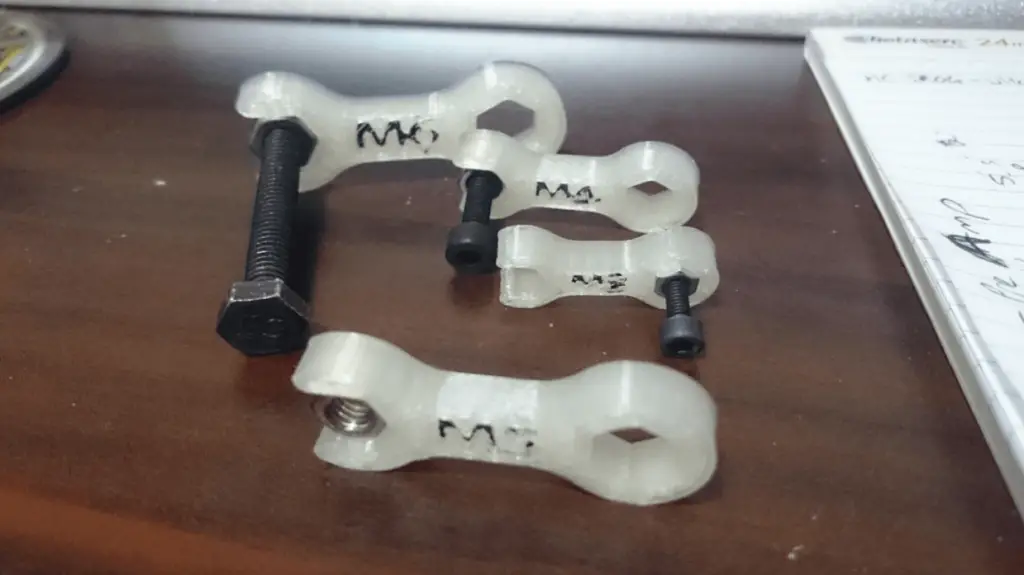Extruder calibration is an essential starting point for optimum print quality. You don’t need to do it every day – but you do need to do it when you change filaments – and it’s a good idea to do it regularly, particularly before large or critical print jobs.
This article reviews causes and fixes for the common feeder issues that arise – and the Anet A8 machines do suffer from a variety of filament feed issues. We lead you through a diagnostic process to pin down likely causes for the symptoms you’re experiencing and the actions you can take to mitigate the problems, to get you back to successful printing.
How To Calibrate Your Anet A8 Extruder
Step 1
Using a marker pen, put a mark on the filament 150mm above the point where it enters the extruder. If the filament is dark, a scrap of builders tape will allow the same reference point marker. The purpose in this is to prepare for an accurate measurement of what should be around 100mm of extrusion, after it is completed.
Step 2
Heat up the extruder hot end to the recommended extrusion temperature for the filament you’re using. It’s important that the temperature is stable, so that the extrusion will be typical of normal operations, so make sure you wait long enough to get to thai condition
Step 3
With your printer connected, you’re going to need to send some individual G—code and M—code commands, so you’ll need to be running a suitable piece of software to send these commands one at a time. There are various software tools that can allow you to do this, Cura being a good example — alternatively you can use Octaprint, Repetier Host or any tool that you’re familiar with.
The first command you’ll need to send is M83 (just that, nothing else), which sets the extruder to ‘relative’ mode. This means that amounts you instruct to be extruded will be compounded, rather than alternating between extrude and suck back. Send 10 and then 50 mm in relative mode, the head will extrude a total of 60 mm in two steps. Send 10 and then 2mm in ‘absolute’ mode, the printer will extrude 10 mm and then suck back 2 mm to aid in clean, high quality printing by reducing leakage/stringing.
Step 4
Without waiting, send the command G1 E100 F100, which instructs the printer to extrude 100 mm of filament. This is the reference amount that you’ll validate by measuring the fed length.
Step 5
Switch off the extruder hot end power and carefully measure the remaining length of filament to the mark you made.
If the length remaining is less than 50 mm, the machine is over extruding. Conversely, if more than 50 mm remains, the machine is under extruding.
Step 6
Send the command M503 from the G—code software you’re using. This will display all settings held in the printer memory, including the E value.
- Our new Filament Printing 101 Course is just for you! Lean how to create perfect professional prints without all the hassle.
- Don't let common mistakes hold you back, click the link to learn more and get ahead now!
Step 7
Input the values you have from the above process into an E Step calculator such as this. This will give you a new E Steps value (XXX.XX) to correct the extrusion amount.
Step 8
Send the command M92 EXXX.XX to enter the new E Steps value into the printer, then send the command M500 to instruct the machine to save all current settings.
That’s it, your E Step calibration is complete – although if it’s the first time you’ve done this, checking that a) the M503 command returns the XXX.XX value you just input and b) re-running the 150 mm measurement and 100 mm extruder actually does extrude 100 mm of filament. If it doesn’t, review for any mis—step and repeat the process with the new extrusion amount that isn’t 100 mm!
Common Anet A8 Extruder Issues
The Anet A8 is a popular and well liked machine, but it is not without issues — and extrusion problems rank high up the list, with a number of potential causes.
Clicking and Not Feeding Filament
First, what is the origin of the clicking? It is the stepper motor that drives the extruder feed gears suffering from ‘lost’ steps. This happens when the force required to turn the gear and feed the filament is greater than the torque that the motor step can provide.
For those who may not be familiar with this, stepper motors advance a fixed degree of rotation per step – and the step is an electrical signal that pulses the motor by ONLY one step. Motors in the extruder use 4.8° steps, which is 75 steps per revolution (of the motor and its gear). If the resistance to movement is more than the motor can overcome, the mechanism will advance a little and then ‘click’ back each step.
How To Fix
Generally, if the inability to advance the filament creeps up on you, it is an extruder problem, or a filament feed problem (or both) and not a fault with the extruder. If it develops from a little clicking to a lot, then the causes are different.
- If you just changed filaments or extruder temperature, then there’s a good chance that a) the hot end is too cool, stalling the filament feed or b) the filament gear tensioner is too tight, stalling the gear directly.
- Either of these is easy to test and correct — increase the extruder temperature if it’s too low, reduce the spring load on the filament if it feels very tight when you push it into the nozzle.
- If the clicking has been increasing, there are two areas of potential faults you can look at to identify the cause;
- The nozzle is blocked — this is a reasonable starting point for investigation and the most likely cause of increasing clicking. Perform a cold pull on the nozzle, use a needle to unblock it from the outer end, clean off the outside and retry a feed command.
- The filament feed is stuck — again, this is quite common, creating a pull problem rather than a push problem. Free up the spool or the filament feed, if it’s a ‘naked’ filament supply. If you have a Bowden tube fitted (as an after market modification) then it may be wear—damage, at a rub point in that tube that is adding the pull resistance. Evaluate and clear the problem, replace the Bowden tube if the problem is evident and serious.
Extruder Motor Not Moving
Clearly the motor must turn, or there’s no feed and no print. If your motor is simply not moving, there are several possible causes you will need to consider.
How To Fix
The potential causes are suggested here, in order of difficulty in investigating and fixing. First you’ll need to remove the small axia cooling fan from the side of the extruder, to see what’s going on;
- Pinch the tension release lever on the extruder and send a feed command. If the motor turns when the filament tensioner is off, it may be a feed problem, but you didn’t get (or didn’t notice) the clicking that often accompanies this. Go back and evaluate feed issues.
- If you find that the motor IS turning, once the fan is off, but the gear is NOT, then it’s most likely that the grub screws that lock the gear to the motor shaft are loose. Reposition the gear and tighten the screws, if that’s the case. This is a commonly reported fault (although usually not reported as the motor not turning, the Anet A8 is not the quietest machine, so it’s possible to be fooled).
- With the fan removed, send an extrude command. If nothing happens, pinch the tension release lever and send the command again. Still nothing? Then it’s likely an electrical problem;
Check for broken wires, poor connections and connectors reversed. If you cannot find any fault and get any movement from the motor, then either the motor itself or the drive electronics has a problem.
To avoid buying parts you don’t need, connect the extruder motor wiring to an axis motor and send another extrude command. If the alternative motor turns, you’ve identified the problem as being in the motor. If it DOESN’T turn, then your driver board is at fault.
As a final check, use the axis wiring to test the extruder motor. If it turns ok, then you can be fairly sure it’s a driver board fault. This is not a high probability (but it does happen), so take a deep breath and investigate very carefully.
Mechanism Jammed
Thermal expansion can jam the extruder, which has a number of cost induced design weaknesses. If the nozzle extension into the feeder gear side of the extruder is set too high, it’s possible for it to hit the extruder gear, stalling it.
How To Fix
Tear down the extruder as a regular maintenance action — and when you refit the nozzle, make sure there’s a small but measurable clearance to the gear. This is a simple mechanism and it can wear and develop a little slack at various points, so a safety margin in this area is a wise choice.
Frequently Asked Questions
How tight should my extruder gear be?
There is no one setting for the pressure on the filament exerted by the spring loaded adjuster — it depends heavily on several variables;
- Softer filaments will get ‘bitten’ more deeply by the pinchwheel/gear and this can cause feed problems by ‘cogging’.
- More slippery filaments, like Nylon, can result in sliding rather than feeding.
- If the tensioner is too tight, spot damage of the filament can result in slipping or locking of the mechanism.
This is a setting that you may need to tune for each filament you use, but a general guide is that when pushed through by hand, the filament should flow without cogging (too tight) or sliding (too loose).
Does the Anet A8 have thermal runaway protection?
Thermal Runaway Protection should be a standard feature on any 3D Printer, reducing the risk of machine damage and potentially fire. It is disabled on the Anet A8.
If and when the hot end temperature sensor fails or gets displaced, the machine will ‘see’ that the hot end is running cold and keep powering up as best it can to compensate – thermal runaway. Thermal Runaway Protection is a simple software feature that monitors for this and shuts down the machine when an instance of the hot end being unresponsive to applied power shows as happening. This is a timer function, to allow enough power—on time for the hot end temperature to respond, but not enough time for overheat damage to happen when it does not. An alarm message explaining the event is a key feature, or the user sees an unexplained stop, which requires a complex investigation of multiple possible causes.
It requires a simple software installation to upgrade to a later version of Marlin (Marlin 2.0 will solve your problem), which includes this protection.




